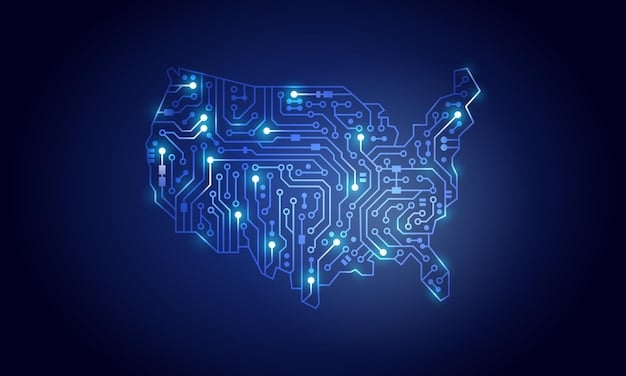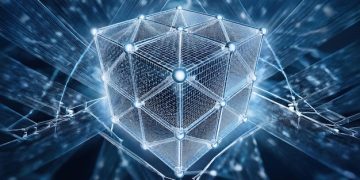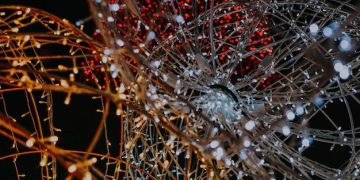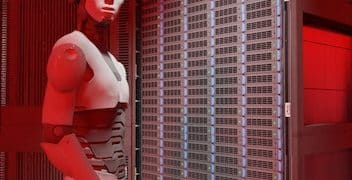Quantum Computing’s Cybersecurity Impact in US by 2025

Quantum computing is expected to profoundly reshape US cybersecurity by 2025, introducing capabilities that could both undermine and enhance existing encryption protocols, necessitating rapid cryptographic updates and strategic defense investments.
The dawn of quantum computing heralds an era of unprecedented computational power, a shift that is set to redefine numerous industries. Among these, national security and, more specifically, How Will Quantum Computing Impact US Cybersecurity by 2025? stands as a critical concern for the United States. This technological leap presents a dual-edged sword: the potential to break current cryptographic standards, thus exposing sensitive data, juxtaposed with the promise of more robust, quantum-resistant security measures. As the US government and private sector grapple with this evolving landscape, understanding the immediate implications and preparing for future challenges becomes paramount.
Quantum Foundations and Cybersecurity Vulnerabilities
Quantum computing leverages the principles of quantum mechanics, such as superposition and entanglement, to process information in fundamentally different ways than classical computers. While early-stage, these capabilities suggest a future where today’s most robust encryption, particularly public-key cryptography like RSA and ECC, could be rendered obsolete. This prospect introduces a significant vulnerability for US cybersecurity infrastructure.
By 2025, fully fault-tolerant quantum computers are not expected to be commonplace. However, even nascent or specialized quantum machines, or even the theoretical understanding derived from their development, could pose a credible threat. Any data encrypted today and stored for future use, often referred to as “harvest now, decrypt later,” faces the risk of being compromised once large-scale quantum computers become a reality.
The Shor and Grover Algorithms
Two quantum algorithms are particularly relevant to cybersecurity. Shor’s algorithm, for instance, can efficiently factor large numbers, directly threatening the mathematical foundation of commonly used public-key encryption. Grover’s algorithm, while not breaking encryption outright, could significantly speed up brute-force attacks, making symmetric-key encryption keys more vulnerable if lengths are not sufficiently increased.
- Shor’s Algorithm: Exploits quantum properties to find prime factors of large composite numbers exponentially faster than classical algorithms, directly impacting RSA and ECC.
- Grover’s Algorithm: Offers a quadratic speedup for searching unsorted databases, potentially reducing the effective key length of symmetric encryption schemes.
- Post-Quantum Cryptography (PQC): The development of new cryptographic algorithms designed to be resistant to attacks from future quantum computers, a critical area of research and standardization.
The implications for US cybersecurity are profound. Critical infrastructure, government communications, financial transactions, and military intelligence all rely heavily on encryption. A disruption of this scale could lead to widespread data breaches, economic instability, and a severe compromise of national security. Preparing for this “quantum leap” requires proactive strategy rather than reactive measures.
Even with quantum computers not being fully mature by 2025, the foresight to anticipate these threats is crucial. Organizations must begin assessing their cryptographic inventories and formulating transition plans to quantum-resistant standards. This includes understanding what data needs protection, for how long, and what current encryption methods are employed. The race to develop and deploy post-quantum cryptography (PQC) is already underway, spearheaded by agencies like the National Institute of Standards and Technology (NIST).
The transition to PQC will not be simple. It involves a massive undertaking of upgrading hardware, software, and protocols across myriad systems globally. Given the complexity and widespread nature of cryptographic dependencies, initiating this process well before the quantum threat materializes is a strategic imperative for the US to maintain its cybersecurity posture.
Strategic Preparedness: US Initiatives in Post-Quantum Cryptography
Recognizing the impending quantum threat, the United States has initiated several strategic programs focused on developing and standardizing post-quantum cryptography (PQC). By 2025, these initiatives aim to provide a roadmap and foundational elements for a quantum-resistant future, although full implementation will extend beyond this timeframe.
NIST has been at the forefront of this effort, running a multi-year process to evaluate and select quantum-resistant cryptographic algorithms. This standardization process is critical because it ensures interoperability and widespread adoption across government agencies, the private sector, and international partners. The selection of initial algorithms is a major milestone towards practical deployment.
NIST’s PQC Standardization Process
NIST’s thorough evaluation process involves cryptographers from around the world, assessing proposed algorithms based on security, performance, and practicality. The selection of algorithms like CRYSTALS-Dilithium for digital signatures and CRYSTALS-Kyber for key encapsulation mechanisms marks a significant step forward.
- Algorithm Selection: NIST announced the first set of PQC algorithms in July 2022, signaling the start of more focused development and integration.
- Industry Engagement: Active collaboration with technology companies and researchers to ensure the selected algorithms are practical for real-world applications.
- Migration Planning: Development of guidelines and best practices for organizations to transition their systems to PQC, considering the scale and complexity of the task.
However, the process is far from complete. NIST continues to evaluate additional algorithms and expects further rounds of standardization to address various cryptographic needs. The challenge by 2025 will be to move from theoretical selection to practical, widespread implementation.
Government agencies, defense contractors, and critical infrastructure operators are already beginning to assess their cryptographic footprint, identifying systems vulnerable to quantum attacks. This involves an inventory of all cryptographic assets, understanding dependencies, and prioritizing migration efforts based on data sensitivity and longevity. The “crypto-agile” paradigm, which emphasizes the ability to quickly swap out cryptographic algorithms, is becoming a key principle in system design.
Moreover, investment in quantum computing research within the US is not solely focused on offensive capabilities. Significant resources are being directed towards understanding quantum mechanics for defensive applications, including quantum key distribution (QKD) and quantum random number generation (QRNG). While QKD has limitations for widespread, general-purpose use, it offers ultra-secure communication channels for specific, highly sensitive applications.

By 2025, the US cybersecurity landscape will reflect increasing awareness and initial steps towards PQC adoption. This includes developing PQC-compliant software libraries, integrating new algorithms into hardware, and training the workforce on quantum-safe practices. The goal is to build a resilient, quantum-resistant digital ecosystem capable of defending against emerging threats.
This proactive stance, supported by robust research and standardization efforts, positions the US to lead in the global race for quantum-safe cybersecurity. While the full impact of quantum computing on cybersecurity will unfold over decades, the foundational work done by 2025 will be crucial in mitigating immediate risks and establishing a secure digital future.
The Urgency of “Harvest Now, Decrypt Later”
One of the most pressing cybersecurity concerns stemming from quantum computing is the “harvest now, decrypt later” threat. This refers to the practice where malicious actors, including state-sponsored groups, collect vast amounts of currently encrypted data, storing it with the intention of decrypting it later once quantum computers capable of breaking current encryption become available. By 2025, this threat is already very real and actively being executed.
Sensitive data – government secrets, proprietary corporate information, personal health records, financial data – if intercepted today, remains encrypted by classical means. However, the lifespan of this data often extends far into the future. For example, national security communications might need to remain confidential for decades, while medical records are often permanently archived. If this data is intercepted and stored now, it becomes a ticking time bomb.
Identifying and Protecting Long-Lived Data
The immediate challenge for US cybersecurity is to identify which data assets are most vulnerable to this “harvest now, decrypt later” scenario. This largely includes information that retains its value over long periods. Organizations must conduct a thorough inventory of their data, classifying it by sensitivity and projected lifespan.
- Data Classification: Categorizing data based on its sensitivity (e.g., top secret, confidential, public) and its required confidentiality period (e.g., 5 years, 20 years, permanent).
- Vulnerability Assessment: Identifying existing encryption methodologies used for long-lived data and assessing their resilience against future quantum attacks.
- Prioritized Migration: Focusing resources on transitioning the most critical and long-lived data to quantum-safe encryption first.
The time horizon for quantum decryption capabilities is uncertain, but experts generally agree it could be within the next 10-20 years. This means data captured today could realistically be compromised within its intended lifespan. Therefore, merely waiting for quantum computers to fully mature before acting is a perilous strategy.
Industries processing highly sensitive or strategic information, such as defense, finance, and healthcare, are particularly exposed. The US government, in particular, has vast stores of classified information that, if ever compromised, could have catastrophic national security implications. Protecting this data now, using quantum-resistant methods where feasible, is not a future problem but a present imperative.
By 2025, awareness of this specific threat is expected to be widespread among cybersecurity professionals. Initial efforts to transition high-value, long-lived data to post-quantum cryptographic standards or alternative protective measures will be underway. This will likely involve a combination of upgrading cryptographic systems for new data, and in some cases, re-encrypting existing archives with PQC. Furthermore, strategies like secure multi-party computation or homomorphic encryption, which allow computation on encrypted data, may also see increased exploration for highly sensitive contexts.
Effectively addressing the “harvest now, decrypt later” challenge will demand significant resource allocation, cross-organizational collaboration, and a consistent focus on cryptographic agility. The US cybersecurity posture by 2025 will be largely defined by how effectively it begins to neutralize this insidious long-term threat.
Quantum Advantages: Boosting US Cybersecurity Defenses
While quantum computing poses significant threats, it also offers avenues for enhancing US cybersecurity defenses. Beyond the direct application of post-quantum cryptography, quantum technologies themselves—or their underlying principles—could provide novel tools for protecting digital assets. By 2025, we could see early-stage exploration and integration of these quantum-inspired improvements.
One promising area is in more robust random number generation. Cryptography relies heavily on truly random numbers for creating keys and nonces. Quantum random number generators (QRNGs) leverage the inherent randomness of quantum mechanics to produce numbers that are genuinely unpredictable, making them superior to most classical pseudo-random number generators.
Quantum-Enhanced Security Tools
The integration of QRNGs into secure systems could significantly strengthen cryptographic foundations. While widespread deployment might take longer, by 2025, QRNGs could be deployed in high-security environments, such as critical infrastructure or sensitive government communications.
- Quantum Key Distribution (QKD): Provides a method for two parties to produce a shared, secret key that is provably secure against eavesdropping, based on the laws of quantum physics. While not a replacement for full cryptographic suites, it offers point-to-point highly secure communication.
- Quantum Machine Learning for Threat Detection: Quantum algorithms could potentially accelerate machine learning processes, leading to more sophisticated and faster anomaly detection in network traffic, identifying both known and novel cyber threats with greater efficiency.
- Quantum Sensing for Physical Security: Quantum sensors, still in early development, might offer ultra-sensitive detection capabilities for physical intrusions or electromagnetic anomalies, complementing traditional physical security measures around critical data centers.
Moreover, quantum computing might enable more efficient and secure methods for data integrity verification and secure multi-party computation. These capabilities allow multiple parties to jointly compute a function over their inputs while keeping those inputs private, which is crucial for secure data sharing and collaboration without exposing sensitive information. This has immense potential for inter-agency intelligence sharing or collaborative threat analysis.
By 2025, progress in these defensive applications of quantum technologies will likely be exploratory and confined to specialized laboratories or pilot projects. However, the foundational research and initial prototypes developed within this timeframe will lay the groundwork for future quantum-enhanced cybersecurity products and services. The US Department of Defense and intelligence agencies are particularly interested in these capabilities to establish an even higher level of security for their most sensitive operations.

The investment in dual-use quantum research means that while some efforts focus on mitigating quantum threats, others actively seek to leverage quantum physics for superior defensive paradigms. This balanced approach is essential for maintaining a competitive edge in the evolving landscape of global cybersecurity. The transition period between now and 2025 will see crucial decisions made about which quantum-advantage technologies are mature enough for initial strategic rollout, and how they can best integrate with existing security architectures to create a truly quantum-safe ecosystem.
Ultimately, the impact of quantum computing on US cybersecurity by 2025 is not solely about the threat; it is about leveraging the very same scientific principles to build a stronger, more resilient defense. This dynamic interplay between offensive and defensive capabilities will define the future of information security.
Government and Industry Collaboration: A Unified Front
The scale of the quantum computing challenge demands an unprecedented level of collaboration between the US government and the private sector. No single entity possesses all the expertise, resources, or infrastructure to address this complex threat alone. By 2025, this collaborative effort will be evident through various partnerships, funding initiatives, and information-sharing frameworks.
The National Quantum Initiative Act, passed in 2018, laid the groundwork for this collaboration, aiming to accelerate quantum information science and technology development. This act fosters a network of quantum research centers and encourages partnerships between federal agencies, national laboratories, universities, and private companies.
Key Collaborative Initiatives
Critical to this unified approach is the sharing of threat intelligence and best practices for PQC migration. The National Cybersecurity Center of Excellence (NCCoE) at NIST, for example, is actively developing practical guidance and reference architectures for transitioning to quantum-resistant cryptography, working directly with industry partners.
- Public-Private Partnerships (PPPs): Formation of joint ventures and consortiums focused on quantum research, algorithm testing, and deployment strategies for PQC.
- Information Sharing and Analysis Centers (ISACs): Leveraging existing ISACs to disseminate information about quantum threats and PQC readiness across critical sectors.
- Workforce Development: Joint government-industry programs to train cybersecurity professionals in quantum-resistant principles and algorithms, addressing a critical skill gap.
Funding for quantum research and development is another crucial aspect of this collaboration. Government grants and contracts stimulate private sector innovation, while industry investments complement federal efforts, creating a robust ecosystem for quantum advancement. This financial synergy ensures that both fundamental research and practical applications are pursued vigorously.
By 2025, expect to see more formalized frameworks for how government and industry share cryptographic transition plans. This includes consistent methodologies for assessing cryptographic risk, prioritizing system upgrades, and validating PQC implementations. Compliance with PQC standards will likely become a requirement for government contractors, driving adoption throughout the supply chain.
Moreover, the cybersecurity community will likely see the emergence of specialized quantum security firms offering consultation, PQC implementation services, and quantum-safe auditing. These firms, often founded by researchers from government or academia, will play a vital role in translating theoretical advancements into deployable solutions for businesses.
International collaboration is also an increasingly important aspect. The US is engaging with allies to harmonize PQC standards and share insights on defensive strategies. A global, interoperable PQC ecosystem is necessary to secure cross-border communications and protect shared economic interests. By 2025, these international dialogues will be well underway, shaping joint approaches to quantum security.
The unified front presented by government and industry collaboration is essential not just for mitigating the quantum threat but for establishing the US as a leader in the quantum age. This synergistic relationship will directly impact the resilience and adaptability of US cybersecurity infrastructure in the face of rapidly evolving technological challenges.
Policy and Regulatory Adaptation for Quantum Readiness
The rapid evolution of quantum computing necessitates significant adaptation in cybersecurity policy and regulations within the United States. By 2025, expect to see legislative and executive actions specifically aimed at guiding the transition to a quantum-resistant future, ensuring compliance and fostering an environment conducive to widespread PQC adoption.
One key policy area will be mandating or strongly recommending the migration to PQC for federal agencies and critical infrastructure. This could take the form of executive orders, agency-specific directives, or even legislative requirements for federal information systems. Such mandates would provide the necessary impetus and funding for a structured transition.
Legislative and Regulatory Pathways
The National Security Agency (NSA) and the Cybersecurity and Infrastructure Security Agency (CISA) are likely to issue updated guidance and technical specifications for PQC implementation, influencing standards across government.
- Federal Acquisition Regulations (FAR): Potential updates to FAR to include PQC compliance requirements for procurements of IT systems and services by federal agencies.
- Industry Standards: Regulatory bodies in sectors like finance (e.g., FDIC, SEC) and healthcare (e.g., HIPAA) may begin to issue guidelines or requirements for PQC to protect sensitive data.
- International Alignment: US policy will likely seek to align with international partners on PQC standards and regulatory approaches to ensure global interoperability and security.
Beyond direct mandates, policy will also focus on incentives for the private sector to adopt PQC. This could include tax credits for research and development into quantum-resilient technologies, or grants for small and medium-sized businesses to upgrade their cryptographic systems. The goal is to accelerate adoption beyond just the top-tier corporations.
Furthermore, policies related to supply chain security will become increasingly important. As PQC algorithms are integrated into hardware and software components, ensuring the integrity and authenticity of these quantum-safe products will be paramount. Regulations may emerge to certify or validate the quantum-resistance claims of vendors.
Legal frameworks for data security and privacy will also need to be re-evaluated. If quantum computers begin to compromise existing encryption, the legal implications for data breaches under current privacy laws (like GDPR, if data has an international component, or state-specific privacy laws) could be significant. Policy adjustments may be necessary to define responsibilities and liabilities in a post-quantum world.
By 2025, the foundational elements of this policy and regulatory adaptation will be in place. Federal agencies will likely have firm deadlines for assessing cryptographic inventories and developing migration plans. Industry will be keenly aware of impending PQC requirements and will be actively engaging with government on implementation strategies. This proactive policy stance is crucial to prevent a “cyber Pearl Harbor” scenario where critical infrastructure and sensitive data become broadly exposed.
While full, pervasive PQC adoption is a multi-decade endeavor, the policy groundwork laid by 2025 will dictate the speed and effectiveness of this critical cybersecurity transition, safeguarding the US’s digital future against quantum threats.
Challenges and the Path Ahead For US Cybersecurity
While the US is making strides in preparing for quantum computing’s impact on cybersecurity, significant challenges remain. By 2025, these hurdles will likely define the immediate path forward, requiring sustained effort, innovation, and strategic investment to overcome.
One of the foremost challenges is the sheer complexity and scale of the cryptographic transition. Organizations, particularly large enterprises and government agencies, rely on a vast and often poorly documented array of cryptographic systems, both hardware and software. Identifying every instance of vulnerable encryption, assessing its criticality, and upgrading it without disrupting operation is an enormous logistical task.
Overcoming Migration Hurdles
The “discovery” phase alone—locating all cryptographic assets—can be daunting. Many legacy systems still in use were not designed to be “crypto-agile,” meaning they lack the flexibility to easily swap out cryptographic algorithms. This often necessitates significant re-engineering or even complete system overhauls.
- Resource Constraints: The demand for cybersecurity professionals skilled in quantum cryptography will far outstrip supply, creating a talent gap.
- Testing and Validation: Thorough testing of new PQC algorithms in diverse real-world environments is crucial, but time-consuming and expensive.
- Supply Chain Dependency: Relying on third-party vendors for software and hardware means organizations are beholden to their PQC readiness, creating potential vulnerabilities.
Another challenge is the performance overhead of some PQC algorithms. While selected for security, some may be computationally more intensive or produce larger key sizes/signatures than their classical counterparts. This could impact network bandwidth, processing speeds, and storage requirements, especially for high-volume transactions or resource-constrained devices.
The standardization process itself, while critical, is also a moving target. As new research emerges, or as understanding of quantum attacks evolves, some PQC candidates might prove less resilient than initially thought. This requires an agile approach to security frameworks, allowing for future algorithm updates and replacements.
Furthermore, maintaining security during the transition period poses a risk. The simultaneous operation of classical and PQC systems, or the gradual rollout of new algorithms, introduces complexity that could be exploited by adversaries. Secure key management, in particular, becomes even more critical during this hybrid phase.
By 2025, the US cybersecurity community will be in the thick of navigating these challenges. While significant progress will be made in setting standards and developing migration plans, the full-scale implementation across all critical sectors will still be years away. The period between now and then will be characterized by pilot programs, continued research into more efficient PQC, and an urgent focus on securing the most sensitive data and systems.
The path ahead involves continuous investment in quantum research, aggressive workforce development, and robust collaboration between government, academia, and industry. The ultimate goal is not merely to react to the quantum threat but to proactively build a quantum-resilient digital infrastructure capable of defending against the most advanced cyber adversaries, ensuring the long-term security of the United States.
| Key Point | Brief Description |
|---|---|
| ⚛️ Quantum Threat | Quantum computers can break current encryption (RSA, ECC), posing a significant risk to US data security. |
| 🛡️ PQC Readiness | NIST is standardizing Post-Quantum Cryptography (PQC) algorithms for future-proof security. |
| ⏰ “Harvest Now” Risk | Adversaries are collecting encrypted data today for decryption by future quantum computers. |
| 🤝 Collaboration is Key | Government, industry, and academia are collaborating to develop and implement quantum-resilient solutions. |
Frequently Asked Questions
▼
Quantum computing uses quantum-mechanical phenomena like superposition to process information, offering exponential speedups for certain computational problems. This poses a threat because algorithms like Shor’s can efficiently break public-key encryption schemes (RSA, ECC) that secure most of our digital communications and data, potentially exposing sensitive information.
▼
It’s highly unlikely that fully fault-tolerant quantum computers capable of breaking all encryption will exist and be widespread by 2025. However, the “harvest now, decrypt later” threat is very real. Data encrypted today could be stored by adversaries and decrypted later when quantum computers become powerful enough.
▼
PQC refers to new cryptographic algorithms designed to be resistant to attacks from both classical and quantum computers. The US, through NIST, has been leading a global standardization process, recently selecting initial PQC algorithms. The focus by 2025 is on developing implementation roadmaps and initiating the transition for critical systems.
▼
Quantum computing can also enhance cybersecurity defenses. Quantum Random Number Generators (QRNGs) provide stronger randomness for keys, and quantum machine learning could improve threat detection. Quantum Key Distribution (QKD) offers ultra-secure communication for specific point-to-point links. These defensive capabilities are being explored to build more robust security architectures.
▼
Key challenges include the massive scale of cryptographic migration across complex systems, the lack of crypto-agility in legacy infrastructure, managing performance impacts of new algorithms, and a significant shortage of skilled cybersecurity professionals. Supply chain dependencies and ensuring security during the transition period are also major hurdles.
Conclusion
The impact of quantum computing on US cybersecurity by 2025 is less about an immediate apocalypse and more about a critical, accelerated transition. While fully mature, large-scale quantum computers capable of breaking all encryption are unlikely to be commonplace by then, the “harvest now, decrypt later” threat is a present reality demanding immediate action. The United States is proactively responding through NIST’s PQC standardization efforts, fostering crucial government-industry collaborations, and beginning the arduous process of policy and regulatory adaptation. The period leading up to 2025 will be defined by strategic planning, initial deployments of quantum-resistant cryptography, and a concentrated effort to identify and protect long-lived sensitive data. Overcoming the immense logistical, technical, and human resource challenges associated with this cryptographic migration will be paramount. Ultimately, the resilience of US cybersecurity in the quantum age hinges on its ability to embrace vigilance, innovation, and a unified, forward-looking strategy that transforms potential threats into opportunities for enhanced defense.





